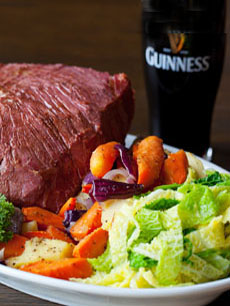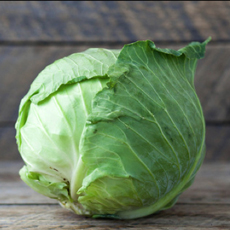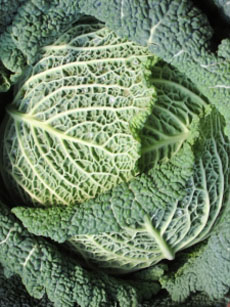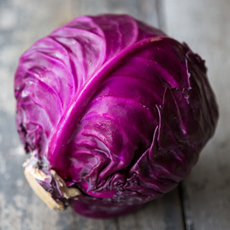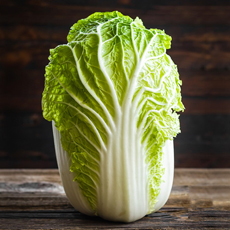ST. PATRICK’S DAY RECIPE: Guinness-Marinated Corned Beef & Cabbage
|
There are numerous food approaches to St. Patrick’s Day beyond a plate of corned beef and cabbage and a beer or two.
From now through St. Patrick’s Day, March 17th, we’ll present a daily recipe. We’re starting out with that corned beef and cabbage, but this one has a holiday twist: a Guinness marinade and champ potatoes. Champ potatoes are a variation of the traditional Irish dish, Colcannon, made with mashed potatoes, shredded kale or cabbage and onions. Check out the history of cabbage, below. Corning refers to curing or pickling the meat in seasoned brine. The word refers to the “corns” or grains of kosher (or other coarse) salt that are mixed with water to make the brine. Typically, brisket is used to make corned beef; the dish has many regional variations and seasonings. Irish immigrants adapted corned beef from their Jewish neighbors on New York’s Lower East Side as a cheaper alternative to Irish bacon, precipitating the now-traditional Irish-American dish, corned beef and cabbage. Smoking a corned beef, and adding extra spices, produces pastrami. |
|
|
|
RECIPE: GUINNESS-MARINATED CORNED BEEF & CABBAGE WITH CHAMP POTATOES This recipe is courtesy of Justin O’Connor, Executive Chef at the Guinness Storehouse in Dublin. It will be served at the restaurant on St. Patrick’s Day. Ingredients For 6 Servings |
||
|
|
Preparation
1. Cook The Beef. Place the beef and Guinness into a pot and cover with cold water. Add onion, cloves, bay leaves and peppercorns. Cook for 2 to 2-1/2 hours, or until tender 2. Cook The Potatoes. Cook the potatoes in salted water; drain and mash. Add two-thirds of the butter, half the cream and the green onions. Season to taste with salt and pepper. 3. Cook The Cabbage. Boil the sliced cabbage in salted water for 5 minutes and drain; add 2 tablespoons of butter and season. 4. Make The Cream Sauce. Take 100ml of the cooking stock and place in a pot, add the other 200ml cream and simmer for 2 minutes whisking in 50g butter. Cabbage is part of the Brassicae botanical family, the group of cruciferous cancer-fighters that also includes bok choy, broccoli, Brussels sprouts, cauliflower, collards, horseradish, kale, kohlrabi, mustard greens, and radishes. Cabbage is eaten raw (including brined, fermented and pickled) or cooked (braised, sautéed, steamed, stewed). While the best-known cabbage dishes may be coleslaw (Holland), corned beef and cabbage (Irish-American), kimchi (Korea), sauerkraut (Germany), and stuffed cabbage (Eastern Europe), the leafy green vegetable is native to the Mediterranean. While cabbage is grown around the world today, scientists can’t pinpoint where it originated, because many plants belong to the Brassicae family, one of which is the ancestor of today’s cabbage. The most common theory is that cabbage was domesticated in Europe some 3,000 years ago, from wild predecessors that had thick leaves. The leaves retained water, which allowed cabbages to survive in colder places with less water (Russia has long been a stronghold for cabbages). Different wild varieties exist in different locations worldwide. In the East, cabbage cultivated in North China has been eaten since 4000 B.C.E. Evidence shows that in central and western Europe, cabbage was domesticated by Celts, whose culture developed in western Europe as early as 1200 B.C.E., and spread to the British Isles, France, and other parts of Europe. Mesopotamia also grew cabbages. The ancient Egyptians didn’t cultivate them until the times of the Ptolemaic dynasty, the last of the Egyptian dynasties (305 to 30 B.C.E.). The Greek Theophrastus (371-287 B.C.E.), considered the “father of botany,” mentions cabbage in his texts as early as 4th-century B.C.E. Cabbage was a favorite of the Greek philosopher Diogenes (412 or 404 B.C.E. to 323 B.C.E.). The Greeks called heads of cabbage krambe while the Romans called it brassica or olus. In Rome, cabbage was considered a luxury and many regarded it as superior to all other vegetables. They also used it for medicinal purposes as relief from gout, headaches, and the symptoms of poisonous mushroom ingestion. Pliny the Elder, the Roman author, philosopher, and naval commander, (23 C.E. to 79 C.E.), wrote about seven known variants of cabbage of the time. Allegedly, both the ancient Egyptians and Romans ate large amounts of cabbage before a night of drinking, which allowed them to drink more before becoming intoxicated. We haven’t tried it—and don’t plan to. |
|
|
Cabbage In Modern Times The first cabbages were brought to America by French explorer Jacques Cartier on his third voyage, 1541 to 1542. Cabbage was brought on long ocean journeys because its high levels of vitamin C prevent scurvy. In its brined form, sauerkraut, the cabbage would last even longer. Ship’s doctors also used it to treat the wounds of sailors and prevent gangrene. Today, China is the largest producer of cabbage, followed by India and Russia. Russia is the world’s largest per capita consumer of cabbage. [Source]
|
||
